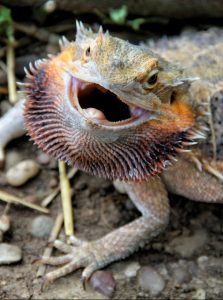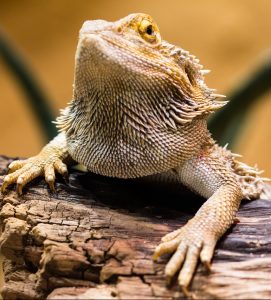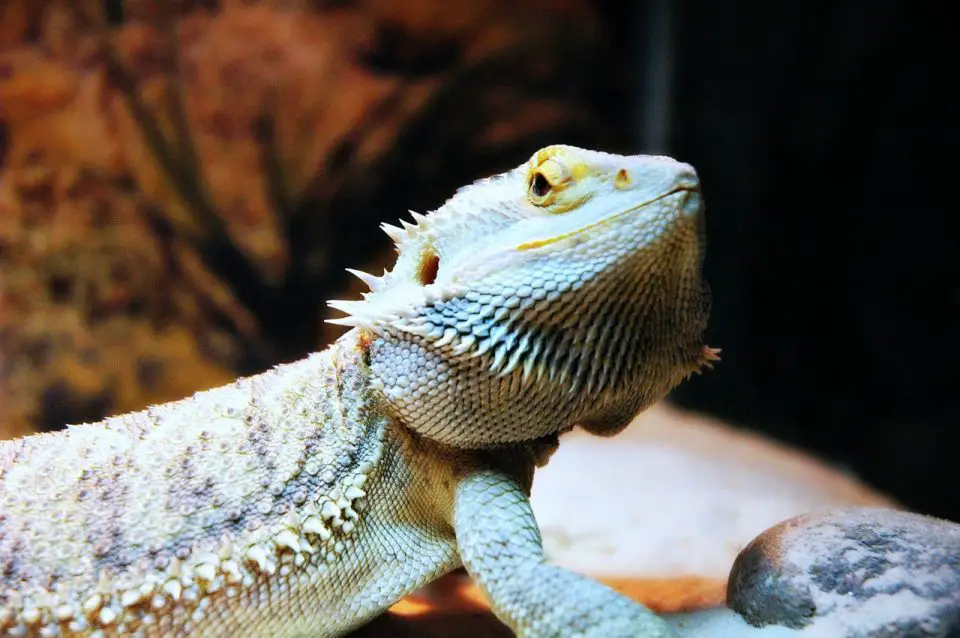If you’ve ever owned a bearded dragon, then you may have noticed they have some pretty strange behaviors such as not peeing or bobbing their heads.
Another popular behavior in bearded dragons that leaves their owners wondering is the fact they wave their arms. As one of their most curious behaviors, it’s hard to know whether or not this is a good thing.
So, why exactly do bearded dragons wave their arms?
Well, this answer is actually really simple! Just like humans, bearded dragons wave as a way to interact with their environment. It’s their way of acknowledging other bearded dragons or animals.
They do it when they’re afraid of another animal to show submission, and they do it to show they are uneasy.
That leads to the next question of whether or not your bearded dragon’s arm waving is an unhealthy behavior you should worry about and attempt to reduce.
To fully understand the meaning behind your bearded dragon’s waving, you need to take a close look at the circumstances around them.
To help you help, here are some of the most common instances that you’ll find your bearded dragon waving in.
Reasons that Your Bearded Dragon is Waving Their Arms
Arm waving is one of those behaviors that could be good or bad depending on the situation.
In some circumstances, it’s a completely natural and harmless action that shows that your bearded dragon is interacting with his or her environment in a healthy way.
Yet, in other situations, it could be because your bearded dragon is distressed or feels unsafe.
In each of the 9 situations below, we’ll go over what is causing your bearded dragon to wave, whether or not it’s a negative behavior, and, if so, how to redirect their energy and help them calm down.
Your Bearded Dragon is Around Another Bearded Dragon and is Aware of Their Presence
This is one of the hardest situations to interpret. When your bearded dragon is waving around another bearded dragon it could mean one of two things.
First, it could be that your bearded dragon is simply acknowledging the presence of the other bearded dragon and saying that he or she sees the other.
This is also your bearded dragons way of saying that they mean no harm.
On the other hand it could be a sign that your bearded dragon is distressed by the presence of the new bearded dragon and is submitting to the other.
The best way to distinguish between these two situations is to continue to monitor the situation and watch for the context of the body language that your bearded dragon is exhibiting.
If he or she continues to show signs that he or she is distressed, you may want to step in and remove your bearded dragon.
Your Bearded Dragon is Showing that He or She is Afraid or Intimidate
 As mentioned above, the main causes for your bearded dragon to wave their arms is a discomfort of some sort.
As mentioned above, the main causes for your bearded dragon to wave their arms is a discomfort of some sort.
If your bearded dragon is waving their arms as well as demonstrating other signs that they are distressed then you can assume that something whether it’s a new item or another bearded dragon is making them afraid or intimidated.
To better understand these triggers here are some of the top reasons why your bearded dragon may be feeling afraid or intimidated.
You Have Two or More Bearded Dragons in one Enclosure
While it is possible to house two or more bearded dragons in one enclosure, in the wild they do not live together.
This means that if you do happen to house two or more together, you may notice signs that one is dominant over the other.
In this case you will notice that the one that is more submissive and appears to arm wave more often as this is their way of showing discomfort and submitting to the more dominant bearded dragon.
If you happen to notice that this is the case with your bearded dragons, consider separating them into different enclosures where they cannot see each other.
If this does not resolve the issue, it may be one of these other problems as well.
You Have Other House Pets
Other bearded dragons in the same enclosure are not the only thing that can intimidate your bearded dragon.
If you have other free roaming house pets, such as a cat or dog, and they have the ability to get near your bearded dragon’s enclosure, then this could cause your bearded dragon to become too stressed.
Your bearded dragon will register these large animals as predators and will wave his or her arms to show their submission to the other house pet.
If you notice that this is the case with your bearded dragon try putting their enclosure on a higher shelf where other house animals cannot reach or consider putting them in their own room and shutting the door.
You Have Recently Relocated Your Bearded Dragon
You may have noticed this before if you’ve ever gotten a new puppy. Animals tend to be very wary in new situations in new environments.
Sometimes even a small relocation such as moving your bearded dragon enclosure to a new room can cause distress.
If this is the case with your bearded dragon there’s nothing to stress about.
After a few days he or she will adjust to their new surroundings and become more comfortable and in this case the arm-waving should settle.
You may also notice this behavior with baby bearded dragons especially if they have been recently adopted into your family.
In this case you may want to take a little bit more time to monitor your bearded dragon as a baby bearded dragon that experiences a large degree of stress for an extended period of time may experience a loss of appetite.
90% of their growing is done in their first 12 months of life so it’s very important that your baby bearded dragon gets the nutrients that they need during this time.
If the arm-waving and signs of distress continue you may want to consider speaking to your veterinarian about alternatives to help them calm down.
There are new Objects in Your Bearded Dragon’s Enclosure
Just like how a new location or environment can cause upset, new things such as toys, plants, rocks, or even decorations can be scary for your bearded dragon and cause them to arm wave out of distress.
In the wild, very few things change dramatically from day to day.
Also, they don’t immediately have an inherent understanding of what toys are, so, if you place a new one in their enclosure, especially one that is big or oddly shaped compared to previous toys, they may not understand at first that it is something to play with and not something that is going to harm them.
Instead of immediately placing new things into your bearded dragon’s enclosure, introduce them to the item slowly in a neutral location so that they are not afraid.
Your Bearded Dragon can see Their Reflection
 Very few animals can spot their reflections in mirrors or other reflective surfaces – such as windows or the glass sides of enclosures – and recognize it as themselves, Bearded dragons are not an exception to this fact.
Very few animals can spot their reflections in mirrors or other reflective surfaces – such as windows or the glass sides of enclosures – and recognize it as themselves, Bearded dragons are not an exception to this fact.
You see, when your bearded dragon is in their enclosure and they happen to see their reflection, they don’t know it’s just their reflection.
Instead, they view it as another bearded dragon in their territory, and, as seen above, this can cause your bearded dragon to become extremely distressed, especially if they view their reflection as the dominant bearded dragon.
Try reducing reflections when possible by using a special wallpaper designed for enclosures.
Your Bearded Dragon can see Outside
Finally, if your bearded dragon can see outside, it’s not uncommon for them to wave.
Think about everything that is outside in your yard that your bearded dragon can see. Many of these things aren’t things that your bearded dragon can recognize.
Or, if they can recognize it, they may recognize it as a predator, such as with birds. This can cause your bearded dragon to feel unsafe and afraid, feelings that they cope with and express through arm waving.
If you notice that this is the problem with your bearded dragon, try finding a new place for their enclosure.
Is Arm Waving Gender Exclusive in Bearded Dragons?
There is a lot of talk and theories about arm waving and gender in bearded dragons.
One of the most popular beliefs is that only female bearded dragons wave while male bearded dragons conduct a motion similar to head bobbing, which is known to be a sign of dominance in the species.
However, this is a common misconception.
Arm waving – and head bobbing as a matter of fact – are not a gender exclusive behavior in bearded dragons. You’ll see female bearded dragons bobbing their head as well as male bearded dragons waving.
This is because the two behaviors aren’t two extremes, they are just two examples of communication, and which one your bearded dragon uses depends on both their personality and the circumstances.
All bearded dragons will be intimidated by something, whether it’s another bearded dragon or a beard or their own shadow.
There are also times when your bearded dragon will feel more dominant and will then show the proper behavior to express that.
So, is Arm Waving an Unhealthy Behavior?
One of the most important things to recognize is that arm waving itself is not an unhealthy behavior.
Rather, this is a natural behavior brought on by instinct that helps your bearded dragon deal with their distress and anxiety.
So, rather than making it your main goal to stop your bearded dragon from arm waving, it is important that you focus mainly on targeting whatever is triggering the arm waving behavior.
If you only focus of preventing the arm waving itself, you are limiting your bearded dragons’ main way of expressing their distress.
This is an important part of their body language and how they communicate and interact with their environment.
There is an expression that relates to this situation that says that you don’t fix an overflowing bathtub by mopping up the mess – you pull the plug out of the drain.
Thus, by targeting the anxiety trigger and not the coping behavior, you will better help your bearded dragon.
Final Thoughts: Why Do Bearded Dragons Wave
 Bearded dragons are amazing expressive animals. Even though they cannot communicate to us using words, they still have many signs and behaviors that help use to know exactly what they are thinking or feeling.
Bearded dragons are amazing expressive animals. Even though they cannot communicate to us using words, they still have many signs and behaviors that help use to know exactly what they are thinking or feeling.
As owners, it is important that we learn to identify these behaviors as well as their triggers so that we can understand our bearded dragons.
If they are expressing distress and discomfort, it is important that we are able to realize this so we can step in and remove them from the situation.
While in the wild bearded dragons are more than capable of handling their selves, when they are pets in captivity, they rely on us to help fulfill their needs, and their mental health is one of those needs.
Arm waving is one of those behaviors that it is important to understand.
Due to the fact that it is both a sign of neutral acknowledge – “Hey, I see that you are in my space, and neither one of us wants to cause harm to the other” – and a sign of distress and fear – “I am viewing you as the dominate creature and submitting you, however, I am also demonstrating the fact that I am afraid and in danger”.
It can be tricky to know exactly what your bearded dragon is trying to say at first.
However, by viewing the context of the situation your bearded dragon is in as well as other behaviors and body language they are demonstrating, you’ll be able to understand your bearded dragon in no time.
And they’ll certainly appreciate the fact that they can trust you can help them out when they feel like they’re in danger!
Thank you for reading why do Bearded Dragons wave. Have a great day!
